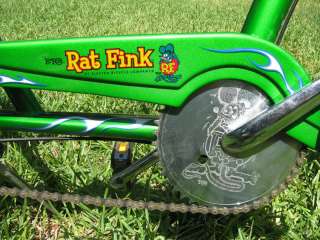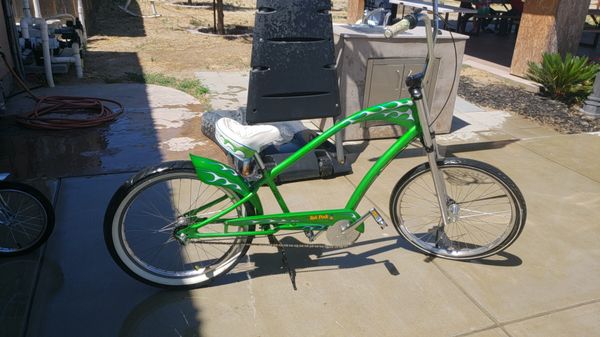

#RAT FINK ELECTRA BIKE FULL#
The design also allows riders to get full extension when they pedal. When the rider is sitting on the saddle, his or her feet can still stand flat on the ground, which feels safer and more comfortable for some riders. This bike’s innovation was what the company calls “Flat Foot Technology,” now more widely known as the crank forward design. In 2003, the company introduced a major new design: the Townie. Car enthusiasts have begun buying Electra bikes. We wanted to make something that would be appreciated by that community.” The bike’s strikingly curved frame and poison green color has inspired widespread press attention, bringing new riders to the Electra brand. “We made a connection with the people who have the licensing for the Rat Fink (logo and name). “We have spent a lot of time at hot rod hangouts during our time in California,” Erforth told the Tacoma News-Tribune. In a more explicit tribute to the car culture, Electra brought out a “Rat Fink” model, licensed by the estate of legendary hot-rodder “Big Daddy” Ed Roth. Models carried hot-rod names like “Rockabilly Boogy” or “Rat Rod.” The company even offered balloon tires with flame-patterned tread. “ Chopper” style elements like shortened rear fenders, racing “slik” tires, and elongated forks were introduced. The lines of the bike frames became more exaggerated, chrome plating was applied liberally, and paint jobs became much more elaborate with flames, metal flakes, and wild colors. These new bikes were still in the cruiser tradition, but were inspired by the Southern California hot rod “kustom kar” culture. In 2002, the company diversified its products, introducing the new “Stream Ride” series. Įlectra advertising in the early days focused on the company’s combination of classic looks with more modern features, such as aluminum frames and multiple speeds, with the tagline “Modern cruisers, with modern components, for modern people.” Hot Rod Influence Today, Electras are available in bike shops throughout Europe, the USA, Japan and Australia. In fact, the fledging company’s cruiser sales were so strong that larger firms were spurred to start offering their own cruiser models. "But people realized they didn't need a mountain bike to go to the grocery store." However, when bike shops tried stocking the Electras, they began to sell, and word-of-mouth convinced more dealers to sign on. At first, "Dealers laughed at us," says Bänziger. The new Electra cruisers were manufactured by a Taiwanese contractor and the two partners began trying to sell them to bike shops. The two remain the firm’s sole shareholders. Erforth said he could sell the kind of bikes Bänziger was designing, so the two pooled $30,000 in personal savings and founded Electra Bicycle Company. About this time, Bänziger met Erforth, a fellow German transplant who was selling pieces of the Berlin Wall. “Back in 1993, there were no cruisers available,” Erforth told the Carlsbad Local News, “You could buy a $99 Huffy at Wal-Mart, or you could try to find an old one and restore it, which is very expensive,” Bänziger decided there was a market niche for a stylish, affordable cruiser bicycle for twentysomethings and began working on designs that combined old school looks with contemporary technology. I wanted to introduce the ‘having a bike in your life’ factor, as opposed to ‘being a cyclist.’” Founding the Company Īt the time, there were very few cruisers, the classic “fun” bike, on the market. Then his attention shifted to bicycles.Īs Bänziger told the San Diego Union-Tribune, “The one thing I found when I looked at cycling in the US was that everything was some kind of sport, but very few people used bikes for fun or for transportation. He had originally planned to start manufacturing snowboards or skateboards, but found that those markets were crowded with competitors and seemed a poor bet for a startup. Bänziger moved to California after graduating with a degree in graphic design, founding his own firm, Projekt Design, in 1990 and doing work for companies like K2 and Adidas.

When he was a teenager, he began designing and manufacturing snowboards in Germany.

Bänziger, a Swiss national, grew up in the Swiss Embassy in East Berlin fascinated with California and action sports.


 0 kommentar(er)
0 kommentar(er)
